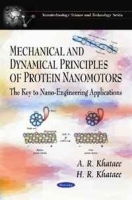| Mechanical and Dynamical Principles of Protein Nanomotors: The Key to Nano-Engineering Applications (Nanotechnology Science and Technology) артикул 11538b. |
 |
It is obvious that movement is an essential concept of all living organisms Molecular motility participates in many cellular functions including cell division, intracellular transport and movement of the organism itself Thus, it is not surprising that nature has evolved a series of biological nanomotors that fulfil many of these tasks A general однэц class of these biological nanomotors is called protein nanomotors that move in a linear fashion (e g the kinesin or myosin or dynein motors) or rotate (e g F0F1-ATP synthase or bacterial flagellar motors) Protein nanomotors are natural motors responsible for the human activity and are also the subject of interest for nanotechnology Protein nanomotors are ideal nanomotors because of their small size, perfect structure, smart and high efficiency Recent advances in understanding how protein nanomotors work has raised the possibility that they might find applications as protein-based nanorobots Thus bio-nanomotors could form the basis of bottom-up approaches for constructing active structuring and maintenance at the manometer scale In this chapter, we have presented structures, mechanisms and potential applications of linear protein nanomotors The three known families of protein nanomotors kinesin, dynein and myosin are multi-protein complexes and share a variety of important features They are responsible for various dynamical processes for transporting single molecules over small distances to cell movement and growth Our reviewing from the mechanism, regulation and co-ordination of linear nanomotors, indicate that the majority of active transport in the cell is driven by linear protein nanomotors All of them convert the chemical energy into mechanical work directly rather than via an intermediate energy Linear protein nanomotors are self-guiding systems They have evolved to enable movement on their polymer filaments, either on cellular or supra-cellular levels and are able to recognise the direction of movement Moreover, each class of nanomotor has different properties, but in the cell they are known to cooperate and even to compete with each others during their function We have also reviewed the potential application of linear protein nanomotors According to this, we predict that linear protein nanomotors may enable the creation of a new class of nanotechnology-based applications; for example, bio-nanorobots, molecular machines, nanomechanical devices and drug deliver systems Thus, protein nanomotors field is very challenging field and is attracting a diverse group of researchers keen to find more. Пуговка -2010 г Мягкая обложка, 63 стр ISBN 1608767345. |